A lowland Nepal trip in February and March 2020
©Carol Inskipp
May 6, 2020
Carol Inskipp (Patron of Himalayan Nature)
From 29th February to 13th March I had a Nepal lowland birdwatching trip that started at Sauraha in Chitwan National Park buffer zone and ended at Shuklaphanta National Park. An old friend, Tika Ram Giri joined me as a guide and Prem Shrestha was our driver.
SAURAHA
At Sauraha as on all my previous Chitwan visits in recent years, I stayed at Chitwan Gaida Lodge, run by Tika and his family. In just two walks, in the morning and late afternoon of 1st March, we recorded as many as 114 bird species. I was delighted that some members of Bird Education Society and also lady guides who I had met the previous year, joined us. Undoubtedly the highlight was a very smart Black-naped Oriole Oriolus chinensis which had been in the area for several weeks. This species was previously thought to be a vagrant to Nepal, but it is probably a rare and local winter visitor. Other species of note included the globally Vulnerable Asian Woollyneck Ciconia episcopus (1) and Great Hornbill Buceros bicornis (1) and the following globally Near-threatened species: one Oriental Darter Anhinga melanogaster, six Ashy-headed Green-pigeons Treron phayrei, a flock of ten Red-breasted Parakeets Psittacula alexandri and 20 Alexandrine Parakeets Psittacula eupatria. Sauraha was the only place we saw Ashy-headed Green-pigeon and Red-breasted Parakeet during the trip. Indeed, nowadays almost all records of Red-breasted Parakeet are from Chitwan National Park and buffer zone. However, we saw Alexandrine Parakeet at all of the lowland places we visited and despite its global status, it is still frequent in Nepal’s protected areas and a few other localities.
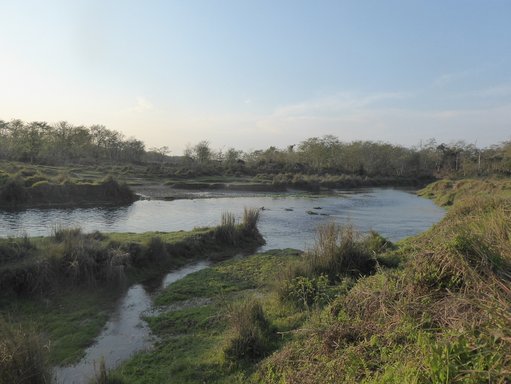
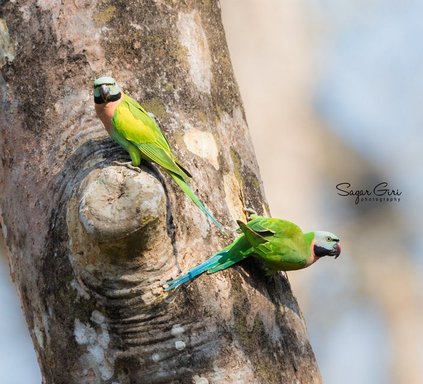
LUMBINI AND JAGDISHPUR RESERVOIR
After Sauraha, Prem drove Tika and me to Lumbini Buddha Garden, a hotel just outside Lumbini, which is ideally situated for birders to explore the Lumbini farmlands and Jagdishpur Reservoir Important Bird and Biodiversity Area. We stayed here for the next two nights. Another old friend, Dr. Hem Sagar Baral, the owner had kindly invited us and joined us birding during our visit. We had some great birding here with the largest day total of our trip (144 species) on 3rd March. Soon after our arrival on 2nd March, we visited the Sacred Ponds, attractive manmade pools that surround the Lumbini shrine and are rich in wetland birds. Highlights included 15 Ferruginous Duck Aythya nyroca (globally Near-threatened) and in the waterside vegetation three Smoky Warblers Phylloscopus fuligiventer. After we returned to Lumbini Buddha Garden, we were treated to a flock of vultures soaring overhead: eight White-rumped Vultures Gyps bengalensis (globally Critically Endangered), two Himalayan Vultures Gyps himalayensis (globally Near-threatened) and 1 Eurasian Griffon Gyps fulvus (nationally Data Deficient).
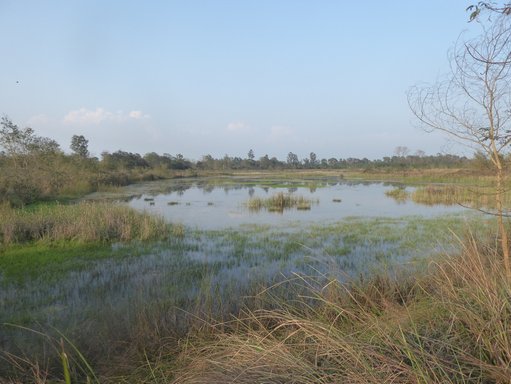
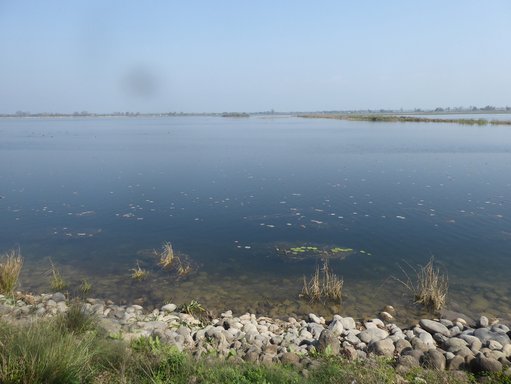
The following day after a quick breakfast we left for Jagdishpur reservoir driving through lowland fields where we had some exciting finds on the way. We saw 12 birds of prey species, a larger number than we found anywhere else on our trip. These included one Long-legged Buzzard Buteo rufinus, two Western Marsh-harriers Circus aeruginosus (nationally Vulnerable), and the following globally threatened species three Egyptian Vultures Neophron percnopterus, two Steppe Eagles Aquila nipalensis and one Eastern Imperial Eagle Aquila heliaca. We were very pleased to have 15 Sarus Cranes Antigone antigone, another globally threatened species – the Lumbini farmlands are the most valuable breeding and foraging area for this crane in Nepal. Three storks were also seen on the way to the reservoir: 30 Lesser Adjutants Leptoptilos javanicus and an Asian Woollyneck (both globally Vulnerable) and 40 Asian Openbills Anastomus oscitans (Nationally Vulnerable).
Jagdishpur reservoir is now one of the best wetlands in Nepal for birds, with rich diversity and high numbers of waterbirds. We found the large number of 14 duck species, including a drake Falcated Duck Mareca falcata (globally Near-threatened and nationally Critically Endangered), 210 Garganey Spatula querquedula (nationally Vulnerable) and eight Ferruginous Ducks. Several raptors were seen, notably a female Pied Harrier Circus melanoleucos (nationally Vulnerable), another two Western Marsh-harriers, and an unusually low altitude Besra Accipiter virgatus. We were delighted to see a White-tailed Lapwing Vanellus leucurus which was previously considered a Nepal vagrant but is probably a rare, local winter visitor to the western lowlands. Other notable records were six Pheasant-tailed Jacanas Hydrophasianus chirurgus (nationally Vulnerable), an additional two Sarus Cranes, six Lesser Adjutants and 40 Asian Openbills; also 150 Little Cormorants Microcarbo niger and 46 Red-naped Ibis Pseudibis papillosa. Among the passerines was Red-breasted Flycatcher Ficedula parva (nationally Data Deficient), and a flock of eight beautiful Blue-tailed Bee-eaters Merops philippinus.
On our return to Lumbini Buddha Garden we had an amazing spectacle of raptors soaring over the semi-natural garden: an Indian Vulture Gyps indicus (Globally Critically Endangered; previously considered a vagrant to Nepal, but probably a rare visitor), four White-rumped and as many as 40 Himalayan Vultures, one Eurasian Griffon, three Indian Spotted Eagles Clanga hastata and a Greater Spotted Eagle Clanga clanga (both globally Vulnerable) and four Steppe Eagles!
Late afternoon we walked along the banks of the Telar River, which is directly opposite Lumbini Buddha Garden beyond the highway. Here we added several more species to our tally for the day, notably two Grey Francolin Francolinus pondicerianus and five Common Babbler Argya caudata (both nationally Vulnerable), and two Himalayan Grasshopper-warblers (West Himalayan Bush-warbler) Locustella kashmirensis (a rare and poorly known species in Nepal).
BARDIA NATIONAL PARK AND BUFFER ZONE
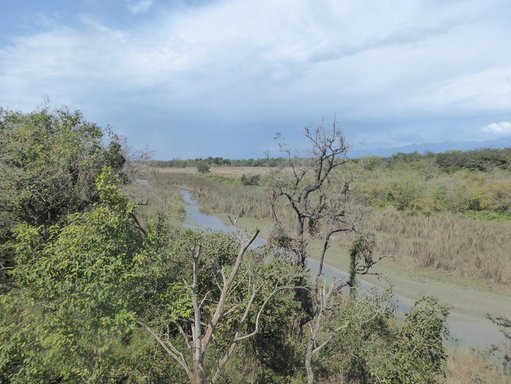
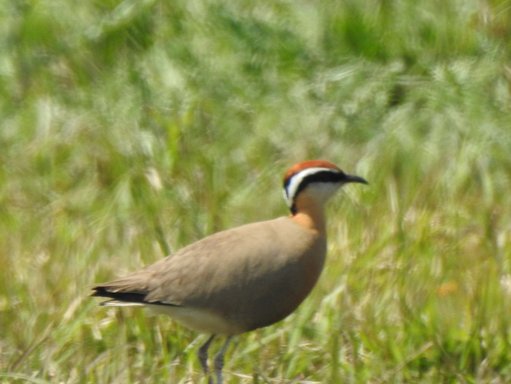
On 4th March we left straight after breakfast for the long drive to Bardia. On the way, we stopped briefly at the Babai River bridge from where we had splendid views over Bardia National Park and the river. Close to the bridge nine Mugger Crocodylus palustris and three Gharial crocodiles Gavialis gangeticus (both globally threatened) were resting on a sandbank. The west felt so pleasantly peaceful compared to central Nepal. At Bardia we had wonderful birdwatching; we spent our first two nights at Royal Tiger Cottage run by Ram Shahi and his family and the next two nights at Samsara Safari Camp run by Raju Thapa and his brother Prem. Both lodges lie in the park’s buffer zone and close to the national park. On our arrival in Bardia, we had a heartwarming welcome from Ram, Raju, and also many of the other Bardia Nature Conservation Club members who joined us birdwatching along the river bank. Here we met Hemanta Acharya, who runs the Bardia Community Based Anti-poaching Unit, a volunteer youth group, that campaigns for conservation and anti-poaching operations in support of the national park. He invited us for tea which we drank listening to Large-tailed Nightjars Caprimulgus macrurus calling at dusk. Ram Shahi (President of the Bardia Nature Conservation Club) and Raju Thapa generously gave us their time to join us for all our birdwatching at Bardia. Royal Tiger Cottage has attractive thatched cottages set in a beautiful garden at the edge of farmland, a lovely place to relax and watch farmland birds; another species here was a Black-headed Bunting Emberiza melanocephala (nationally Vulnerable).
On 5th March we spent a very productive morning at Blackbuck Conservation Area at Khairapur which lies close to the national park. We were thrilled to see a pair of nesting Indian Spotted Eagles, an adult male Pied Harrier, and three specialities here: ten Indian Coursers Cursorius coromandelicus and 12 Yellow-wattled Lapwing Vanellus malabaricus (both nationally threatened) and herds of Blackbuck Antilope cervicapra. Other species of note were a Horsfield’s Bushlark (Singing Bushlark) Mirafra javanica (probably the first for the site) and a flock of 20 Hume’s Lark Calandrella acutirostris.
Next, we went to Kothiaghat where Ram produced a delicious picnic lunch and coffee which we had watching White-tailed Stonechat Saxicola leucurus and Ashy-crowned Sparrow-larks Eremopterix griseus. By the river, we saw two pairs of Asian Woollyneck, an Asian Openbill, and five River Lapwings Vanellus duvaucellii (globally Near-threatened).
The next day (6th March) we were delighted to meet Dr. Rabin Kadariya, Conservation Officer at the Bardia Conservation Programme/National Trust for Nature Conservation who is very supportive of the Bardia Nature Conservation Club.
Birding highlights included two Indian Nuthatch Sitta castanea, a quite recent split and new for the national park, and had brief views of a Pallas’s Fish-eagle Haliaeetus leucoryphus (globally Endangered). After a heavy rain shower over Betani Community Forest, we saw a Fork-tailed Swift Apus pacificus (another first for the national park) together with 2-3 White-throated Needletails Hirundapus caudacutus.
That afternoon we moved to Samsara Safari Camp. We had a warm goodbye from Royal Tiger Cottage; Tika and I planted trees in the cottage garden, at Ram’s invitation. We had an equally warm welcome at Samsara Safari Camp which is close by and also has a beautiful garden. A huge silk cotton tree stands by the track just outside Samsara and all day it was full of birds feeding on nectar from the gorgeous red flowers.
On 7th March we were pleased to meet Yana Nath Baral, Chief Warden at Bardia National Park and his staff, and to hear about their work. After that, we had a trip into the park in an NTNC vehicle that Rabin generously lent us and had a very enjoyable time. Among the bird highlights were two nests with young of Dusky Eagle-owls Bubo coromandus (nationally Critically Endangered); an adult was in one nest with the young, and at the other nest, the adult was close by. We also had a pair of Great Hornbill Buceros bicornis (globally Vulnerable), an immature Grey-headed Fish-eagle Icthyophaga ichthyaetus (globally Near-threatened) and a pair of Changeable Hawk-eagles Nisaetus cirrhatus at their nest. In the Khata corridor at dusk, we were excited to have a pair of Mottled Wood-owl Strix ocellata (nationally Data Deficient) in the same area as Ram had first found the owl for Nepal a few years ago. Many Savanna Nightjars Caprimulgus affinis, as well as Large-tailed Nightjars, were seen and heard calling at dusk here.
We spent the following morning at Betani forest where we saw a few new forest birds for the trip including Large Woodshrike Tephrodornis virgatus though bird of the day was a Rufous-bellied Eagle Lophotriorchis kienerii which we saw just before leaving Bardia. On the Chisapani Bridge that spans the river leaving Bardia, we were delighted to see an adult Pallas’s Gull Larus ichthyaetus in breeding plumage flying over the river – a species that Tika had hoped we would find here.
GHODAGHODI LAKE AREA
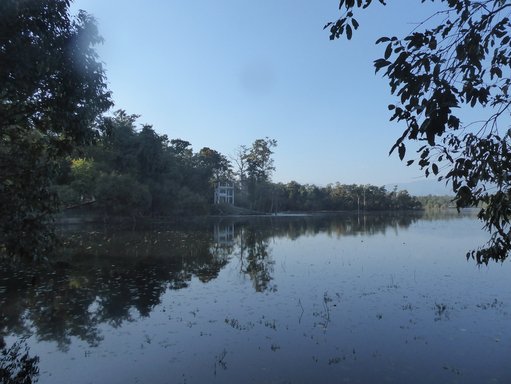
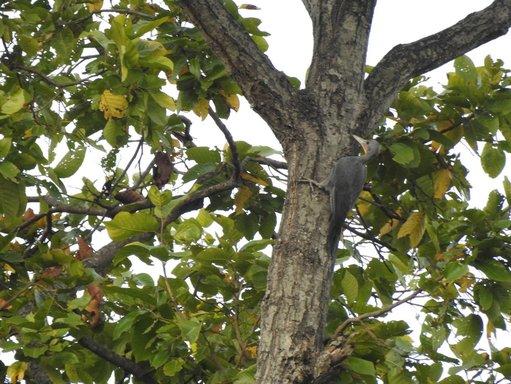
After leaving Bardia, Prem drove Tika and me onto to Ghodaghodi Lake area where we were very pleased to meet Dayaram Chaudhary and his colleagues of the local NGO, the Bird Conservation Network. Bird highlights at this beautiful lake included Cotton Pygmy-goose Nettapus coromandelianus, Yellow Bittern Ixobrychus sinensis, Asian Woollyneck, and Oriental Darter. We spent that night at Ghodaghodi and the following morning Dayaram showed us the Cotton Pygmy-goose breeding site - the main one in Nepal for this species. Next, we visited the beautiful tropical broadleaved community forest of Betani which lies in the catchment, but we were unlucky to have persistent fog that morning that spoilt our birding. The highlight was a Pale-footed Bush-warbler Hemitesia pallidipes (nationally Vulnerable) that Tika Giri heard here.
Although being an Important Bird and Biodiversity Area and a RAMSAR site, Ghodaghodi's ecosystem is under threat mainly from overfishing, bird hunting and trapping, deforestation, pollution and over-grazing. Project Ghodaghodi's Guardians (jointly run by Himalayan Nature, Zoological Society of London, Ghodaghodi Municipality, Ministry of Forest and Environment and others) is working hard with the local community to protect Ghodaghodi and restore the ecosystem.
SHUKLAPHANTA NATIONAL PARK
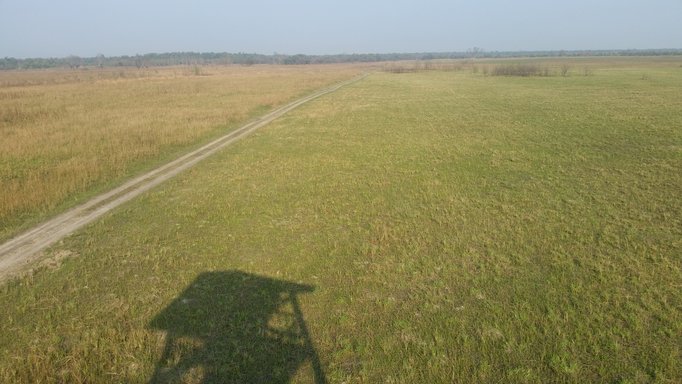
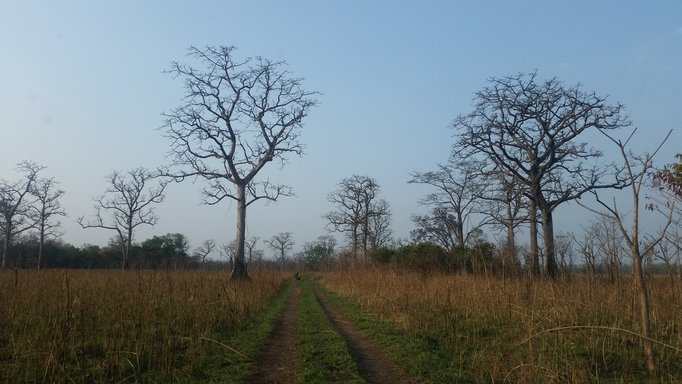
Shuklaphanta National Park was our next destination and we reached here late afternoon. We had been kindly invited to stay by the Chief Warden Laxman Prasad Poudyal although very, unfortunately, he had to leave the following morning, though he was able to join us for a late afternoon walk. He generously let us stay in the park headquarters and his staff looked after us very well indeed. Yam Bahadur Rawat, Ranger and Devraj Joshi, an excellent field worker from the National Trust for Nature Conservation at Shuklaphanta joined us for all our birding at Shuklaphanta and were invaluable in helping us to find birds. We had exceptionally good birdwatching during our three-day visit.
On the main grassland (or phanta) we were lucky to see all the grassland specialities. I especially wanted to see Bengal Florican Houbaropsis bengalensis, a globally Critically Endangered bustard as my husband, Tim and I had carried out the first Nepal survey of this species in 1982 when the park held the largest number in the country. Sadly, only about seven birds are thought to occur in the park today and we saw one of these in flight, a splendid adult male.
I was thrilled with three adult male White-throated Bushchat (Hodgson’s Bushchat) Saxicola insignis perched conspicuously on the tops of tall dead grass stems in the main grassland. Shuklaphanta was considered to be the main known wintering ground for this globally Vulnerable species but it has declined here in recent years, though the reasons are not understood.
Other grassland specialities included a flock of 20 Finn’s Weaver Ploceus megarhynchus (globally Vulnerable) regular foraged for grain at the park’s elephant stables near the edge of the main Phanta (which Devraj told us). About 15 Black-breasted Weaver Ploceus benghalensis (nationally Vulnerable) also fed at the elephant stables. Indian Grass-babbler (Rufous-rumped Grassbird) Graminicola bengalensis (globally Near-threatened) was seen each time we visited the main phanta with a maximum of eight.
Two more globally Vulnerable and elusive species were seen in marshy grassland at the edge of the main phanta: a group of three Jerdon’s Babblers Chrysomma altirostre (a rare resident in the park) and a Wood Snipe Gallinago nemoricola, which took flight low over the ground with heavy wing flaps before settling a short distance away. This was the first record of Wood Snipe from Shuklaphanta; it breeds in the subalpine zone and has rarely been recorded at low altitudes in Nepal, mainly from Chitwan and Bardia National Parks.
Another new species for the park was Indian Nuthatch Sitta castanea near the park headquarters on 12th March. It is interesting that Chestnut-bellied Nuthatch Sitta cinnamoventris was heard in the park on 11th March. Indian Nuthatch and Chestnut-bellied Nuthatch have quite recently been split.
Flocks of globally threatened vultures each day were amazing to watch. The largest numbers were on 10th March a mixed flock of one Red-headed Vulture Sarcogyps calvus, three White-rumped Vultures Gyps bengalensis and one Slender-billed Vulture Gyps tenuirostris (all three globally Critically Endangered), and 28 Himalayan Vultures Gyps himalayensis and four Cinereous Vultures Aegypius monachus (both globally Near-threatened). A pair of Slender-billed Vultures was seen at a nest on 12th March. On 11th March we were excited to spot an adult Laggar Falcon Falco jugger (globally Near-threatened, very rare in Nepal) soaring overhead with four Himalayan, one White-rumped and one Cinereous Vulture. This was the first record of Laggar from the national park.
A visit to Jhilmilla in the park on 11th March was especially rewarding. Highlights were: 12 globally Vulnerable Swamp Francolin Francolinus gularis, three adult male Jerdon’s Bushchats Saxicola jerdoni and two song-flighting Striated Grassbirds Megalurus palustris (both nationally Critically Endangered species), one Black Bittern Ixobrychus flavicollis (nationally Endangered), one Asian Woollyneck and one Himalayan Grasshopper-warbler heard.
We had looked for Great Slaty Woodpecker Mulleripicus pulverulentus (globally vulnerable) without success at Bardia and Ghodaghodi, but finally caught up with this species on 11th March. Four birds gave us prolonged views, calling and posturing on the trunks of mature trees, and one was seen by Devraj on 12th March near the park headquarters.
Two Near-threatened species were seen at Ranital: a Black-necked Stork Ephippiorhynchus asiaticus on 12th March and three adults and one immature Grey-headed Fish-eagle Icthyophaga ichthyaetus on 10th March and one adult on 12th.
Our biggest surprise was an adult female Black-breasted Thrush Turdus dissimilis – a new species for Nepal, seen with a Tickell’s Thrush Turdus unicolor in a dense broadleaved forest by a small Radhapur stream.
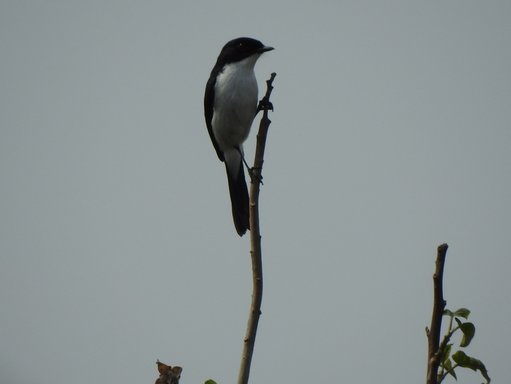
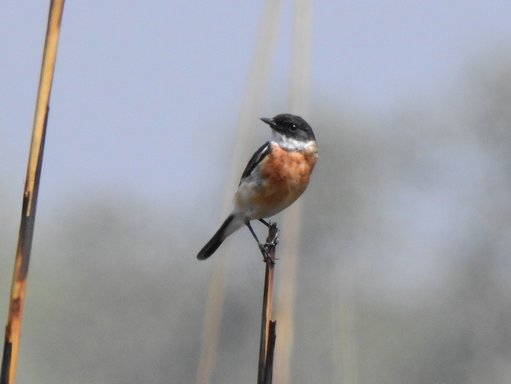
Another surprise new species for the park was a Great Barbet Psilopogon virens, first seen on 9th March and again on 12th at a new low altitude record for the species in Nepal of 170 m (previously seen in Nepal rarely down to 300 m). Two days of unusually heavy rain on 7th and 8th March may have brought down this barbet and the storm may also account for the Black-breasted Thrush, so far west of its normal wintering range.
Other notable records include six Indian Coursers Cursorius coromandelicus (nationally Endangered) on the main phanta on 10th March – this species was last recorded in the park in 2012 according to Devraj. An adult male Hen Harrier Circus cyaneus (nationally Vulnerable) was seen hunting over the main phanta on 12th March. On 10th March at the edge of the main phanta an unusually early Indian Cuckoo Cuculus micropterus was heard calling and at dusk a very large flock of around 3,000 Pale Sand Martin Riparia diluta was seen with 16 Barn Swallows Hirundo rustica.
Early evenings, which we spent sitting outside at the park headquarters, were particularly enjoyable when we heard up to two Oriental Scops-owls Otus sunia (nationally Data Deficient), two Brown Boobooks Ninox scutulata, two Spotted Owlets Athene brama, two Jungle Owlets Glaucidium radiatum, an Indian Scops-owl Otus bakkamoena and two Large-tailed and one Savanna Nightjars.
On 13th March our lowland trip came to an end. Early morning Tika and Prem dropped me at Dhanghadi airport for my Kathmandu flight (which was on time) and they set off for their long drive back home to Chitwan.
The birding far exceeded my expectations: a total of 330 species was recorded including five ticks for me. This, together with the kindness, generosity and good fun of my companions made the trip one of my most enjoyable in Nepal. Special thanks go to Tika for finding most of the birds and looked after me so well and to Prem who proved to be an excellent driver and to both Tika and Prem for their reliability and good humour throughout.